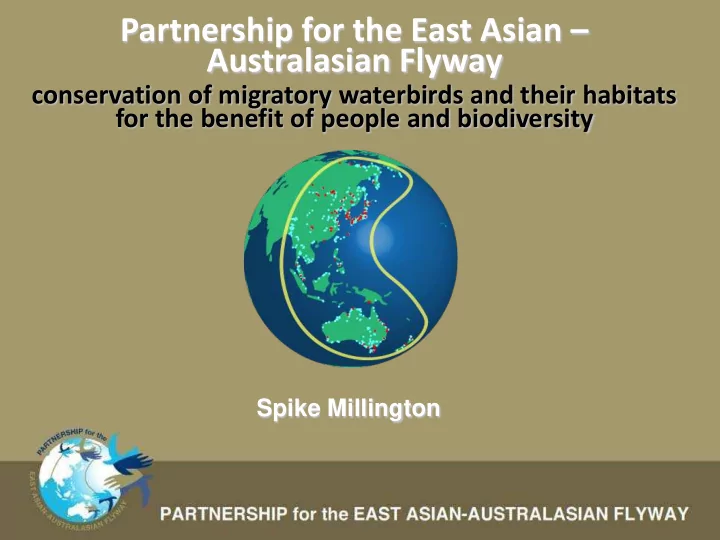

Partnership for the East Asian – Australasian Flyway conservation of migratory waterbirds and their habitats for the benefit of people and biodiversity Spike Millington
A Flyway in Crisis
Migratory Waterbirds on the EAA Flyway At least 50 million waterbirds of more than 200 species Highest Number of Threatened Species: 33 globally threatened Highest number of declining species (annual declines of 9% for some shorebirds)
Flyway Land birds Waterbirds Soaring birds Seabirds TOTAL 4/191 5/128 1/20 4/49 9/319 Pacific Americas 2% 4% 5% 8% 3% 17/286 6/92 1/30 0/15 23/378 Central Americas 6% 7% 3% 0% 6% 17/253 6/138 0/26 1/42 23/391 Atlantic Americas 7% 4% 0% 2% 6% 6/172 11/126 3/28 4/42 17/298 East Atlantic 3% 9% 11% 10% 6% Black Sea– 13/194 10/108 9/37 0/25 23/302 Mediterranean 7% 9% 24% 0% 8% East Asia– East 19/208 14/124 12/42 0/25 33/332 Africa 9% 11% 29% 0% 10% 17/199 13/108 11/37 0/16 30/307 Central Asia 9% 12% 30% 0% 10% East Asia– 27/293 34/178 15/44 5/45 61/471 Australasia 9% 19% 34% 11% 13% Numbers and percentages of threatened and near-threatened migratory species by type and flyway (Kirby 2010).
(Kirby 2010)
Target 12, By 2020 the extinction of known threatened species has been prevented and their conservation status, particularly of those most in decline, has been improved and sustained
Slipping Away ..
Challenges to Conserving Migratory Waterbirds on the EAA Flyway Most countries on the flyway are experiencing rapid, large-scale economic development Consequently, extensive loss of habitat is occurring, including reclamation of intertidal mudflats and conversion of freshwater floodplain wetlands for intensive agriculture.
Aichi Target 5: By 2020 the rate of loss of all natural habitats is at least halved ... and degradation and fragmentation is significantly reduced
Available at: www.iucn.org/asiancoastalwetlands
The CBD commissioned Review of Global Assessments of Land and Ecosystem Degradation and their Relevance in Achieving the Land-based Aichi Biodiversity The CBD commissioned Review of Global Targets identified wetlands as the most Assessments of Land and Ecosystem Degradation and degraded ecosystem among the six their Relevance in Achieving the Land-based Aichi assessed . Biodiversity Targets identified wetlands as the most degraded ecosystem among the six assessed
Aichi Target 11: At least 10 per cent of coastal and marine areas, especially areas of particular importance for biodiversity and ecosystem services, are conserved through effectively and equitably managed, ecologically representative and well connected systems of protected areas and other effective area-based conservation measures, and integrated into the wider landscapes and seascapes. Netw ork Sites ( 1 2 0 sites) I m portant Sites ( Approx. 9 5 0 sites)
Aichi Target 14 By 2020, ecosystems that provide essential services, including services related to water, and contribute to health, livelihoods and well-being, are restored and safeguarded, taking into account the needs of women, indigenous and local communities, and the poor and vulnerable.
Coastal Habitats in EAAF support the livelihoods and security of 1.5 billion people in 22 countries
Wetland Ecosystem Goods & Services • Water supply and quality • Food and livelihoods • Climate change mitigation & adaptation • Nutrient cycling • Recreation & tourism • Cultural values
Breaking Down Seawalls In n the he Humber er es estuar ary, m manag anaged r rear earran angem ement was as found nd t to hav have a e a positiv ive net e net pres esen ent v val alue e af after ar around 3 30 to 40 year ears, r reachin eaching a a benef enefit it of ab about £ £11.5 m million o over er a a per erio iod o of 50 year ears.
Wallase sea Island, U UK
The long term benefits of restoring coastal wetlands include: • Reduced flood defense costs • Reduced flood risks • A more robust coastline to deal with climate change • Improved and more productive sustainable fisheries and shell fisheries • Re-creation of pollution and carbon soaks to improve water quality and prevent carbon emissions • Re-creation of natural landscapes as a global and national natural heritage with aesthetic and cultural values • Increased biodiversity, including nesting, feeding and roosting migrating birds, a shared international concern • Increased tourism revenues and associated benefits • Restoration projects support income generation and provide job creation opportunities • International recognition of sustainable economic development • Social security and well-being.
Next Steps • Potent ntia ial f for Lau aunch nch o of Coas astal Res Restoratio ion Chal allenge at e at CBD COP12 ( (par art o of Korean ean Biodi diver ersity I Initiat ative? e?) • Rev Revie iew o of Coas astal Res Restoratio ion B Bes est Pract actice • Guidanc nce and and Tools • Par artnership hips and and Cap apac acit ity B Buildin ing ( (e. e.g Yel ellow Sea ea – Wad adden en S See) ee) • Demon onstrat ation S n Sites
Thank you for your attention. www.eaaflyway.net
Recommend
More recommend